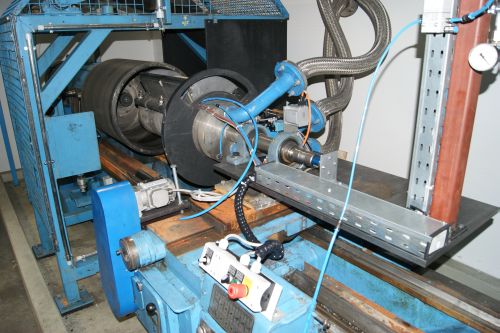2012 /2013
Automatisierung eines Dichtleistenprüfstandes
Jahrgang
Projektpartner
Röchling Leripa Papertech GmbH & Co. KG
Maturanten

Klammer Philipp
5BAT

Mahringer Stefanie
5BAT

Wagner Susanne Stefanie
5BAT
Betreuer

Stockinger Thomas

Starlinger Josef

Grömer Herbert
Problemstellung:
Im Jahr 2000 hat die Firma Röchling LERIPA Papertech eine alte Drehmaschine in einen Prüfstand für Kunststoff-Dichtleisten umgebaut. Mit diesem wird das Verschleißverhalten verschiedener Material-Verbindungen getestet, um so optimale Werkstoffe für die unterschiedlichen Anwendungen herausfinden zu können. Dazu werden die Dichtleisten in einen Saugkasten eingelegt, um eine Vakuumkammer zu begrenzen. Der Saugkasten wird anschließend in eine Walze eingefahren, die im Betrieb gedreht wird. Durch eine Vakuumpumpe wird in der begrenzten Kammer ein Unterdruck erzeugt. Diese Bedingungen entsprechen den Anforderungen an die Dichtleisten in der Papierproduktion.
Nach heutigen Maßstäben ist dieser Prüfstand, vor allem im Bereich der Steuerung, stark veraltet. Zudem müssen alle Verstellungen sowie das Ein- und Ausfahren des Saugkastens manuell durchgeführt werden.
Zielsetzung:
Einige Komponenten des Prüfstandes sollen erneuert und die Steuerung auf den Stand der Technik gebracht werden. Zusätzlich soll die Maschine um einige Komponenten erweitert werden.
Die einzelnen Aufgabenstellungen lauten wie folgt:
- Kurbel zum Ein- und Ausfahren des Saugkastens durch Motor ersetzen
- Sensoren für Drehmoment der Walze, Öldruck der Lagerschmierung und Schalldruck während des Betriebs hinzufügen
- Verstellung der Dichtleisten durch Motor realisieren
- Bedienpult als Touch-Panel neben dem Prüfstand ausführen
- Steuerungsprogramm modernisieren
- Prozessdaten protokollieren
Ablauf:
- Abmessung des Prüfstandes und Übertragung in CAD-Programm
- Messung der notwendigen Leistung des Verfahrmotors
- Festlegung der zu erneuerbaren Komponenten
- Entwurf und Auslegung der mechanischen Bauteile in 2D-Konstruktion
- Arbeitsvorbereitung und mechanische Fertigung durch die schuleigene Werkstatt sowie in seltenen Fällen durch externe Werkstätten
- Montage und Elektroinstallation
- Programmierung der Steuerung und des Bedienpanels
Ergebnis:
Der Prüfstand wurde Anfang Mai 2013 fertiggestellt und arbeitet seither zufriedenstellend.
Verwerdbarkeit:
Der Nutzen für den Auftraggeber liegt in der nicht unwesentlichen Reduzierung des Betriebsaufwandes durch die Automatisierung aller Bewegungen am Prüfstand sowie in der erhöhten Prozesssicherheit, die durch die modernisierte Steuerung gegeben ist.
Systembeschreibung:
Das Ein- und Ausfahren des Saugkastens erfolgt über einen Drehstromasynchronmotor mit einem Getriebe und einem Keilriemen zur Anpassung der Drehzahl.
Die Steuerung wurde mithilfe der Software LabVIEW realisiert. Die Auswertung der Sensoren und die Ansteuerung des Schrittmotors zur Dichtleistenverstellung funktionieren über Kommunikationsmodule der Firma National Instruments, die Frequenzumrichter der bereits vorhandenen Motoren für Walze und Vakuumpumpe werden mit einer seriellen RS485-Verbindung angesteuert.
Die Bedienung durch den Benutzer erfolgt nun über einen Touchscreen neben dem Prüfstand, mit dem fast alle Funktionen der Maschine gesteuert werden. Einzige Ausnahme bildet der Verfahrmotor, der mit einem separaten Bedienpult direkt am Prüfstand kontrolliert wird, auf welchem sich auch der Not-Aus-Schalter befindet.
Presentation of the problem:
In the year 2000 the company Röchling LERIPA Papertech has converted an old turning machine into a test plant for seal strips made of plastics. With this plant different combinations of materials are tested to find the best suitable substances for variable applications. For this purpose the seal strips were placed in a leech box to border a vacuum chamber. The leech box is now inserted into a roll which rotates during the process. A vacuum pump generates a depression in the bordered chamber. The now prevailing conditions are the same as the ones that affect the seal strips in the paper production.
Based on today’s standards, the test plant is out of date, especially in terms of the control system. In addition to that, all adjustments and the moving of the leech box have to be driven by hand.
Objective:
Several components of the test plant should be replaced and the control system has to be set up to state-of-the-art technology. Secondly the plant should be extended with some new components.
The individual assignments of the tasks are:
- Replace the crank handle for the movement of the leech box by a motor
- Add sensors for the torque of the roll, the oilpressure of the lubrication of the bearing and the sound pressure during the process
- Implement the adjustment of the seal strips with a motor
- Realise the operator console as a touch-panel near the test plant
- Modernise the control system
- Log the process data
Sequence of events:
- Measuring of the test plant and feeding the data into CAD-program
- Gauging the needed power of the movement motor
- Selecting the components which have to be exchanged
- Designing and dimensioning of the mechanical prefabricated parts in 2D-construction
- Preparation and mechanical production by the school workshop and by external workshops if required
- Assembling and electric installation
- Programming of the control system and the control panel
Result:
The test plant has been accomplished in May 2013 and is working satisfactorily since this time.
Usability:
The benefits for the employer can be seen in the essential reduction of the complexity of the process due to the automation of all movement systems of the test plant. The modernised control system offers also an increased process stability.
Description:
The movement of the leech box is carried out by a three-phase induction motor which is combined with a gear mechanism and a V-belt for the coordination of the rotation speed.
The control system is realised with the software LabVIEW. The interpretation of the sensors as well as the triggering of the step motor for the adjustment of the seal strips operate via communication-modules from the company National Instruments. The electronic frequency converter of the already existing motors of the roll and the vacuum pump are actuated by a serial RS485-connection.
The user controls the process by a touchscreen near the test plant, which combines the signals of almost every functional device of the machine, except for the movement motor of the leech box. This part is controlled by a separate control panel, which is directly installed at the test plant. An emergency stop is placed on this panel too.


